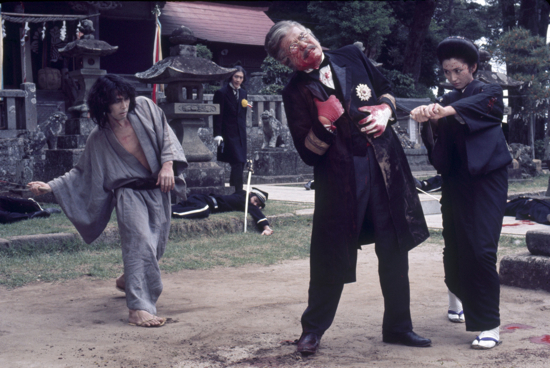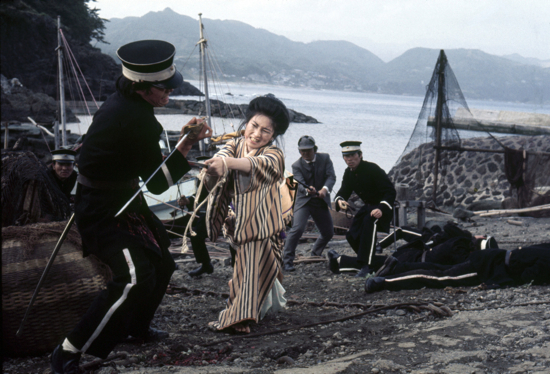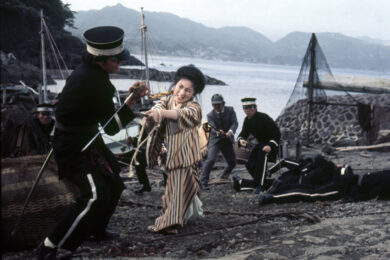"Yuki, you were born for vengeance, poor child – a child of the netherworld." These words, a mixture of defiance and despair, are the first from a mother to her infant daughter. They’re whispered to the girl as she lies in her cot in a women’s prison, on a snowbound night, in late 19th century Japan. The young Yuki grows to become Lady Snowblood: moral assassin, fleet of foot, swift of blade and influential upon Quentin Tarantino.
If you haven’t seen Toshiya Fujita’s cult heroine before, or if you’re already familiar with her deadly dexterous deeds, you should know that the samurai movies that bear her title – Lady Snowblood (1973) and Lady Snowblood 2: Love Song Of Vengeance (1974) – are now available as a lavish Dual Format Edition thanks to Arrow Video. Expect a good deal of sanguinary sword fighting, dismembered limbs, spurting knife wounds and enough blood to make the earth run red. As one of many gnomic voices opines: "What cleans this world is not pure snow, but the fire-red snow of the netherworld." Only a brave soul would disagree.
Played by the exquisitely beautiful Meiko Kaji, the title character became a cult figure for world cinema enthusiasts during the 1970s, but earned greater prominence when Tarantino used Fujita’s pictures as inspiration for his Kill Bill flicks. Lady Snowblood is the origin for O-Ren Ishii, played by Asian-American actress Lucy Liu, and it’s said that the director made the Kill Bill cast listen to Lady Snowblood‘s signature song ‘The Flower Of Carnage’. "Stray dogs howl in the distance as she walks," it lyrically rings. His additional borrowings include a snow-flecked mise-en-scène and a gory showdown at a masquerade party. But these films stir deeper interest than merely being the objects of Tarantino’s homage. Their creative characteristics cast light on Japanese history and culture. Made when the nation was looking back on a century of turbulent times, they were part of a cultural mood that gave expressive relief to collective inner tension. They might be brutal but their projecting fountains of spewing blood were also cathartic.
Lady Snowblood is an allegorical icon. Western eyes could arguably see her as a fusion of grim reaper, avenging angel and Robin Hood figure. Trained in martial arts and samurai expertise, she sets out to trace and kill the four culprits who murdered her father and destroyed her family. Her violence (not unproblematically) has a moral base. One instance sees her confront a murderous gang leader. Impaled on her sword, with his dying breath he hisses: "Who are you?" She answers: "Revenge." He asks: "For who?" She retorts: "For all those helpless people who suffer because of you."
Originating in the manga tales of animators Kazuo Koike and Kazuo Kamimura, Lady Snowblood crosses historical time in Japan’s folk memory. Though set during the period following the Meiji Restoration of 1868, when the country grew conflicted between tradition and modernity, the stories reflect upon the late 1960s, early 1970s and Japan’s attempts to understand a century of turmoil: martial success, imperialism, martial failure, nuclear desolation, ethical decadence.
Japan’s manga traditions reach back to early 19th century illustrating forms, but during the US occupation after World War II its resurgence saw the genre grow more technically adept and fashionably stylish. Yet traditional concerns for ancient morality and idealism endured. This mix is echoed in Fujita’s screen adaptations, which blend old and new techniques, involving extravagant live action, animation, voice-over and non-linear plotting. The narrative string swirls in a figure of eight and viewers must do some gap-filling, but the story gradually emerges.
Fujita is unconcerned with evoking realistic elements or establishing fixed settings. Instead, his camera angles are disorientating, while Masaki Tamura’s fine cinematography is vividly expressionistic, like dreamy surrealism. The keeper of a troubled moral flame, like some Jungian archetype, Lady Snowblood comes from nowhere yet belongs everywhere. "Life is transitory," we’re told, "but the virtues are eternal."

The first feature is stronger than its sequel, dealing with Lady Snowblood’s personal quest. The second sees her embroiled in political conspiracy and, though hugely watchable, loses a little by focussing away from her unblinking gaze. More like moral parables than social narratives, these films might lack the intellectual complexity of classic Japanese cinema (Kurosawa, Ozu, Mizoguchi) but they do not lack idealistic purpose. Their magical and folkloric narrative style is emotionally expressive, evolving from, say, Kaneto Shindo’s Onibaba (1964) and leading towards, for example, Hideo Nakata’s Ring (1998) or Takashi Miike’s Audition (1999).
Special features on the new editions include an illustrated booklet entitled ‘The Crimson Kimono’, created by aficionado and critic Thomas Mes, plus an interview with Japanese cinema expert Jasper Sharp. Girls will love Lady Snowblood for her empowered feminist appeal; guys will love her because, well, if a guy had to die the death of a thousand cuts he’d feel privileged to take it from Meiko Kaji. Fujita’s movies are an intriguing joy, for cultural historians, cineastes and boozy post-pub parties alike.
Lady Snowblood is out now in a multi-disc Blu-ray/DVD package, containing both features plus extras, courtesy of Arrow Video.



